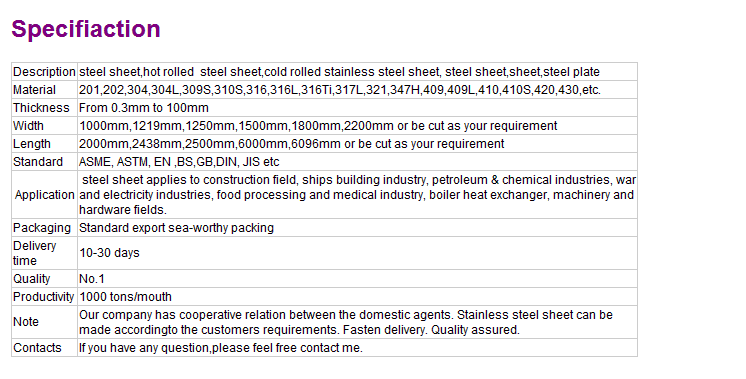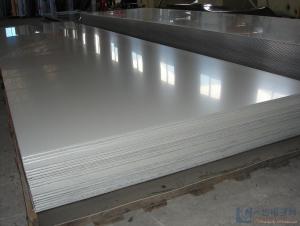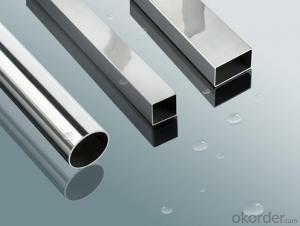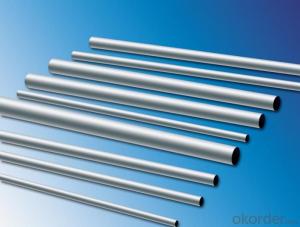316 round stainless steel bar price for china
- Loading Port:
- Tianjin
- Payment Terms:
- TT OR LC
- Min Order Qty:
- 100 kg
- Supply Capability:
- 1000 kg/month
OKorder Service Pledge
Quality Product, Order Online Tracking, Timely Delivery
OKorder Financial Service
Credit Rating, Credit Services, Credit Purchasing
You Might Also Like



- Q:How do you calculate the pipe volume for a specific application?
- In order to determine the volume of a pipe for a specific application, several important factors must be taken into consideration. Initially, it is necessary to ascertain either the inner diameter (ID) or the outer diameter (OD) of the pipe, depending on the information available. Typically, the diameter is measured in inches or millimeters. Subsequently, the length of the pipe needs to be measured, which can be accomplished in either feet or meters. Once the diameter and length have been obtained, the formula for calculating the volume of a cylinder can be utilized to determine the pipe volume. This formula is expressed as V = π * r^2 * h, where V represents the volume, π denotes a mathematical constant approximately equal to 3.14159, r signifies the radius of the pipe (which is equal to half of the diameter), and h represents the length of the pipe. If the ID is known, the radius can be directly calculated as half of the ID. However, if the OD is provided, it is necessary to subtract the pipe's wall thickness from the OD in order to find the ID and subsequently calculate the radius. Once the values have been substituted into the formula, the pipe volume can be solved for. The resulting volume will be expressed in either cubic inches or cubic meters, depending on the units used for the diameter and length.
- Q:What are the different types of stainless steel pipe valves?
- Various stainless steel pipe valves are available, each serving specific purposes and industries. Some commonly utilized types include: 1. Ball valves: These valves control fluid flow with a rotating ball featuring a central hole. They possess excellent sealing capabilities, making them suitable for high-pressure applications. 2. Gate valves: Flow control is achieved through a sliding gate in gate valves. They are commonly employed in situations that require a straight-line flow with minimal pressure drop. 3. Globe valves: Globe valves consist of a spherical body and a regulating disc that moves vertically. They offer effective throttling abilities and are often utilized in applications that demand precise fluid flow control. 4. Check valves: These valves permit fluid to flow in only one direction and prevent backflow. They are frequently installed in piping systems to prevent damage caused by reverse flow. 5. Butterfly valves: Butterfly valves utilize a rotating disc within the pipe to regulate flow. Their lightweight, compact nature and cost-effectiveness make them suitable for a wide array of applications. 6. Needle valves: Needle valves possess a slender, tapered stem that allows for precise control over flow rates. They are commonly found in applications that necessitate accurate flow regulation, such as laboratory or instrumentation systems. 7. Pressure relief valves: These valves automatically release excess pressure from a system when it surpasses a certain threshold. They are crucial for maintaining the safety and integrity of piping systems. These examples represent only a fraction of the stainless steel pipe valves available. The choice of valve depends on factors such as fluid type, pressure, temperature, and specific application requirements. It is important to consult with a valve expert or engineer to select the most suitable valve for your specific needs.
- Q:Can stainless steel pipes be used for gas transportation?
- Indeed, gas transportation can indeed make use of stainless steel pipes. Stainless steel, known for its resistance to corrosion, possesses the ability to endure high-pressure circumstances. This characteristic makes it suitable for the conveyance of diverse gases such as natural gas, propane, and hydrogen. The strength, durability, and ability to withstand extreme temperatures exhibited by stainless steel pipes render them an unquestionably dependable choice for gas transportation. Moreover, the non-reactive nature of stainless steel guarantees the preservation of gas integrity and reduces the likelihood of contamination. All in all, the gas industry extensively employs stainless steel pipes due to their reliable nature, safety, and prolonged lifespan.
- Q:Are stainless steel pipes suitable for dairy applications?
- Yes, stainless steel pipes are highly suitable for dairy applications. They offer excellent corrosion resistance, hygiene, and durability properties required for the handling of dairy products. Additionally, stainless steel pipes can be easily cleaned and maintained, ensuring the highest standards of food safety and quality in dairy processing.
- Q:Are stainless steel pipes recyclable?
- Indeed, stainless steel pipes can indeed be recycled. As a remarkably sustainable material, stainless steel possesses the ability to be recycled endlessly without compromising its characteristics. Consequently, stainless steel pipes can be melted and reconfigured into fresh stainless steel goods, rendering them a prized asset within the recycling sector. The recycling procedure for stainless steel pipes encompasses the collection and categorization of the pipes, their subsequent melting in a furnace, and finally their transformation into novel products. The act of recycling stainless steel pipes not only safeguards our natural resources but also diminishes energy consumption and greenhouse gas emissions linked to the manufacturing of new stainless steel.
- Q:How do stainless steel pipes compare to polypropylene pipes?
- Stainless steel pipes and polypropylene pipes are two popular choices for various plumbing and industrial applications, and they have distinct characteristics that set them apart. Firstly, stainless steel pipes are known for their exceptional durability and strength. They can withstand high pressure and temperature conditions, making them suitable for applications that require robustness and reliability. On the other hand, polypropylene pipes are not as strong as stainless steel and may not be suitable for high-pressure environments. Secondly, stainless steel pipes have excellent corrosion resistance properties. They are highly resistant to rust, corrosion, and chemical reactions, making them ideal for plumbing systems that handle corrosive fluids or gases. Polypropylene pipes, while resistant to many chemicals, may not have the same level of corrosion resistance as stainless steel pipes. Thirdly, stainless steel pipes offer excellent hygiene and cleanliness. They have a smooth interior surface that discourages the growth of bacteria and biofilm, making them suitable for applications in the food and beverage industry or medical facilities. Polypropylene pipes, while relatively resistant to bacterial growth, may not provide the same level of cleanliness as stainless steel. Additionally, stainless steel pipes are known for their longevity and low maintenance requirements. They have a longer lifespan compared to polypropylene pipes, which may need to be replaced more frequently. Stainless steel pipes also require less maintenance and are less prone to leaks or cracks. However, it is worth noting that polypropylene pipes have their advantages too. They are lightweight, easy to install, and relatively cost-effective compared to stainless steel pipes. Polypropylene also has excellent thermal insulation properties, which can be beneficial in certain applications. Ultimately, the choice between stainless steel pipes and polypropylene pipes depends on the specific requirements of the project. Factors such as pressure, temperature, corrosion resistance, cleanliness, and budget should be considered to determine the most suitable option. Consulting with a professional plumber or engineer can help in making an informed decision.
- Q:What are the common shapes of stainless steel pipes?
- Stainless steel pipes come in various shapes that are widely utilized across different industries. These shapes comprise of round pipes, square pipes, rectangular pipes, and oval pipes. Round pipes rank among the most prevalent shapes and find extensive use in diverse applications. They are primarily employed for fluid and gas transportation, as well as the conveyance of other materials. Furthermore, round pipes are well-suited for structural purposes like handrails, scaffolding, and support beams. Square pipes possess a square cross-section and are commonly employed in construction projects, architectural designs, and furniture manufacturing. They offer a sleek and contemporary appearance, often utilized for framing structures, manufacturing shelves, and creating decorative elements. Rectangular pipes possess a rectangular cross-section and are frequently utilized in the construction, engineering, and manufacturing industries. They are often employed in building frameworks, manufacturing gates, fences, and various structural components. Oval pipes possess an elliptical or oval shape and are used in applications where aesthetics play a significant role. They are a popular choice in architectural designs, the automotive industry, and decorative applications. In conclusion, the selection of stainless steel pipe shape depends on the specific requirements of the application and desired aesthetics. Each shape offers distinct advantages and is chosen based on factors such as strength, durability, ease of fabrication, and overall design requirements.
- Q:Can stainless steel pipes be used for hydrogen fuel cell systems?
- Stainless steel pipes are indeed applicable for hydrogen fuel cell systems. Renowned for its exceptional resistance to corrosion, stainless steel proves itself suitable for the manipulation of hydrogen gas. The transportation and storage of hydrogen gas are integral to hydrogen fuel cell systems, and stainless steel pipes serve as a dependable and long-lasting solution for this purpose. Moreover, stainless steel pipes exhibit the capacity to endure high pressure, thereby rendering them an ideal choice for the safe conveyance of hydrogen gas. In conclusion, owing to their corrosion resistance, robustness, and ability to operate in high-pressure surroundings, stainless steel pipes are widely utilized in hydrogen fuel cell systems.
- Q:How do stainless steel pipes compare to PEX pipes?
- Stainless steel pipes and PEX pipes have different characteristics and applications, which make them suitable for different plumbing systems. Stainless steel pipes are known for their durability and strength. They are highly resistant to corrosion, which makes them ideal for use in water supply systems, especially in areas with aggressive water conditions. Stainless steel pipes can withstand high pressure and temperature, making them suitable for both residential and commercial applications. They are also fire-resistant, which adds to their safety profile. Additionally, stainless steel pipes have a long lifespan and require minimal maintenance, making them a cost-effective option in the long run. On the other hand, PEX pipes are made of cross-linked polyethylene, which offers flexibility and ease of installation. PEX pipes are highly resistant to freezing and bursting, making them suitable for cold-climate regions. They have the ability to expand and contract, which reduces the risk of leaks or bursts due to temperature changes. PEX pipes are also corrosion-resistant, eliminating the need for expensive and time-consuming maintenance. Additionally, PEX pipes are quieter compared to metal pipes, as they dampen noise and vibration. When choosing between stainless steel pipes and PEX pipes, it is essential to consider factors such as the specific plumbing requirements, budget, and local building codes. While stainless steel pipes excel in durability and strength, PEX pipes offer flexibility and ease of installation. Ultimately, the choice between the two will depend on the specific needs of the plumbing system and the preferences of the homeowner or plumbing professional.
- Q:Can stainless steel pipes be used for steam applications?
- Yes, stainless steel pipes can be used for steam applications. Stainless steel is highly resistant to corrosion and can withstand high temperatures, making it a suitable choice for carrying steam. Additionally, stainless steel pipes have excellent strength and durability, ensuring a reliable and long-lasting performance in steam applications.
1. Manufacturer Overview |
|
|---|---|
| Location | |
| Year Established | |
| Annual Output Value | |
| Main Markets | |
| Company Certifications | |
2. Manufacturer Certificates |
|
|---|---|
| a) Certification Name | |
| Range | |
| Reference | |
| Validity Period | |
3. Manufacturer Capability |
|
|---|---|
| a)Trade Capacity | |
| Nearest Port | |
| Export Percentage | |
| No.of Employees in Trade Department | |
| Language Spoken: | |
| b)Factory Information | |
| Factory Size: | |
| No. of Production Lines | |
| Contract Manufacturing | |
| Product Price Range | |
Send your message to us
316 round stainless steel bar price for china
- Loading Port:
- Tianjin
- Payment Terms:
- TT OR LC
- Min Order Qty:
- 100 kg
- Supply Capability:
- 1000 kg/month
OKorder Service Pledge
Quality Product, Order Online Tracking, Timely Delivery
OKorder Financial Service
Credit Rating, Credit Services, Credit Purchasing
Similar products
New products
Hot products
Hot Searches
Related keywords





























